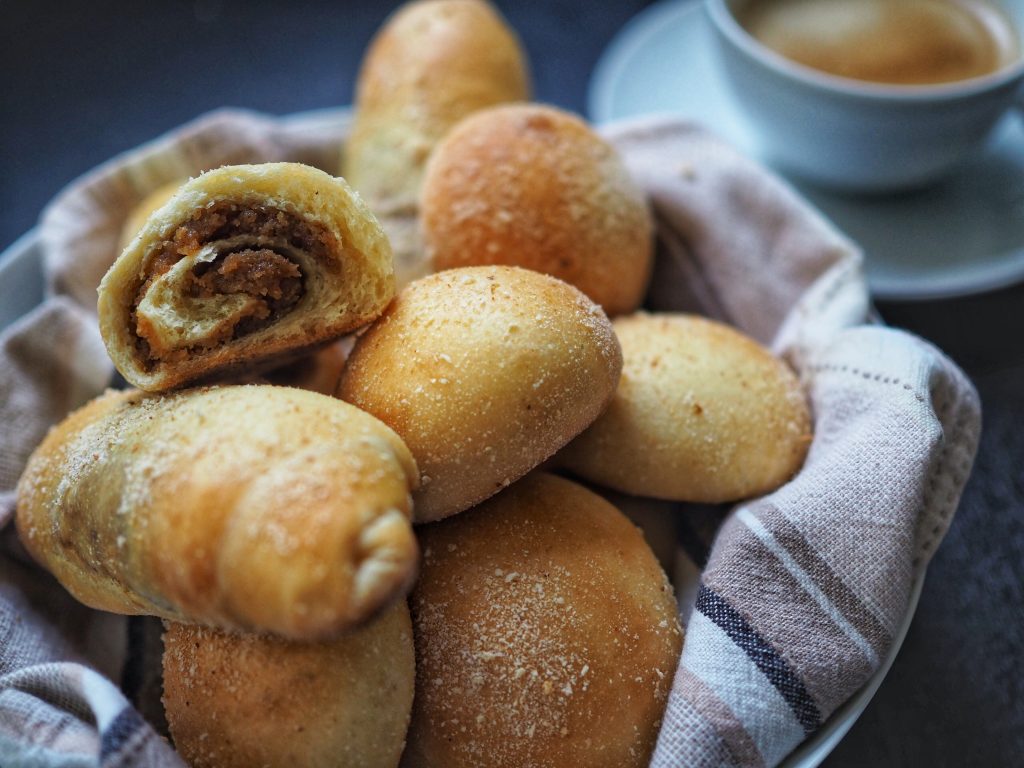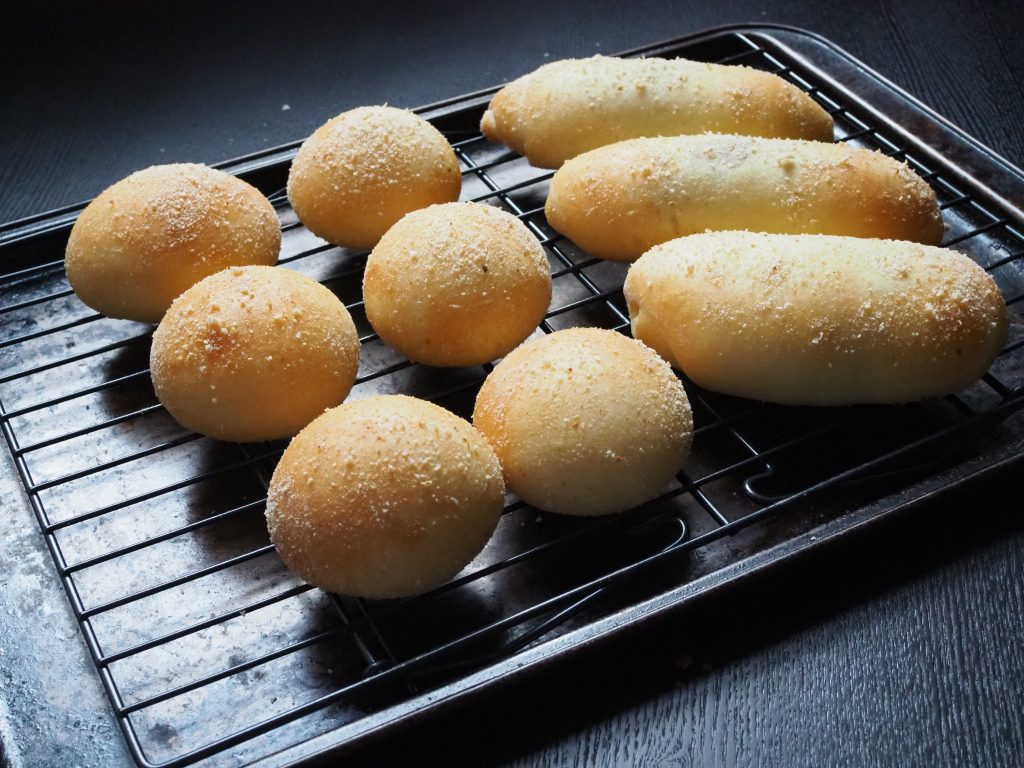
Pan de Sal & Spanish Bread
Today, I’ll tell you about the simplest and most common. It’s called pan de sal. We used to have pan de sal for breakfast with condiments like butter and jam or we have it for merienda or tea time, paired with stir fried noodles. Yes, you read that right, we have noodles and bread rolls at tea time. Pan de sal dough is also used as the base for a sweet bread roll called Spanish bread. Spanish bread is normally paired with coffee because it has a butter and sugar filling, so it won’t go down well with noodles.

Spanish bread and pan de sal are two of the breads that you will find in 95% of the local Philippine bakeries, and today I’m sharing with you the recipes for both. I do apologise for the lack of explanation on the bread names. I really don’t know why they are called such. Pan de sal is not even salty and Spanish bread did not come from Spain… Go figure. ?
I’m sharing these recipes with you because they bring me back to my childhood. These days, because I have a little more free time than normal, I am able to think about my childhood more and I feel a little bit more connected to my roots. If you’re like me, who has lived in different countries, maybe you understand what I’m talking about. Being able to stop and reflect on my life and remember what growing up was like was one of the few good things this pandemic and lockdown has brought about, and I hope some of you also took the time to do the same.

So here are the recipes for these very delicious Filipino bread rolls, you will find the pan de sal recipe first then the Spanish bread recipe follows. I make one recipe for the dough and use half for pandesal and half for Spanish bread because our household size is quite small. If you do this, make sure you only make half the filling. It will make 14 pandesal and 9 Spanish bread. I even made a video to guide you along!
Let me know if you try the recipe and what you think. Also, don’t forget to use #mrsfancypants to get featured on social media!
Equipment notes:
At home, I always use my stand mixer when I make bread, it’s just a pain-free and mess-free alternative to kneading the dough on the bench top. I own the Kenwood Chef XL and I love it. It has a powerful 1400W motor and a large mixing bowl that can hold 6.7L. Now if you’re a Kitchenaid fan, then I would suggest getting the Kitchenaid Pro Line because it’s more powerful than the artisan at 500W and has a bowl that can take up to 6.9L of liquid. I once worked in a kitchen that uses this mixer and it wasn’t too bad. Click the links or the photos below to shop at Myer & The Good Guys.
I get a lot of questions about stand mixers, and these are my recommendations. It comes with a caveat though, I only recommend you get one if you bake a lot because they are not cheap. Otherwise, a hand mixer is the more practical option.
Click on the photos to shop for the products. Most products ship internationally.
Mrs.Fancypants earns a small commission from affiliate links, when you buy the products above. If you’re in Australia, feel free to check the availability on advertised sites.
Pandesal
Makes 2 dozen
Pan de Sal is a Filipino bread roll that is normally served warm with condiments during breakfast but also sometimes during afternoon tea or merienda alongside stir fried noodles or pancit. This recipe makes a 24 pcs. and was adapted from Woman Scribbles.Ingredients
Instructions
- In your stand mixer bowl, mix together the dry ingredients (yeast, sugar, salt and flour)
- In a second bowl or a measuring jug, mix wet ingredients except 1/4 cup milk.
- Attach the dough hook to your mixer and slowly mix the wet ingredients into the dry ingredients on low to medium speed. See if the mixture looks dry and add the remaining 1/4 cup milk gradually until the mix looks doughy.
- Knead the dough for 10-15 minutes on medium speed or until the gluten is developed. You will know that the dough is ready when you take a small bit of dough and stretch it and it doesn't tear, and the dough is smooth and pulls away from the sides of the bowl.
- Cover and let rise in a warm place for 45 minutes or until doubled in size.
- Punch down the dough and divide into 24 balls of 45g grams each. If you don't have a scale, supply divide into 28 equal-sized balls.
- Roll into small ovals then roll in bread crumbs. Place on cookie sheets with a little space in between to give them room to expand. Cover and let rise for 30-40 minutes or until doubled in size. Preheat oven to 170C.
- Bake at 170C for 10 minutes or golden brown. Serve warm with softened butter and condiments.
Notes
1. Milk should not be over 37C or the yeast will die.
Spanish Bread Recipe
Makes 18 rolls
Spanish bread is a Filipino soft bread that is best described as a rolled pan de sal with butter & sugar filling. Served during morning or afternoon tea or merienda, it is also one of the staple items sold at the neighbourhood bakeries in the Philippines. This recipe makes 18 pcs and was adapted from Woman Scribbles.
Ingredients
-
For the dough:
- For the Filling:
Instructions
- Make the pan de sal dough as instructed in the recipe, until the first rise.
- While the dough is rising, make the filling. Warm up the butter in a sauce pan until it's bubbling vigorously, then add the flour. Cook the flour out for 3-5 minutes on medium to high heat. This way your filling will not taste like raw flour.
- Add the breadcrumbs, sugar and milk. Stir until incorporated then cover and set aside.
- Punch down the dough and divide into 18 balls of 60g each. Again, if you do not have a scale, just divide the dough into 18 equal portions.
- With a rolling pin, roll out each ball into an oval shape about 2mm thick and spread a tablespoon of the filling. Then roll up and put on a cookie sheet. There should be just enough filling for 18 rolls.
- Repeat for all the portions and make sure you leave enough space between each roll for proofing. Cover and set aside in a warm place. Leave to rise for 30-45 minutes or until doubled in size.
- Preheat oven to 170C. Brush each roll with milk then sprinkle breadcrumbs on top. Bake for 12-15 minutes or until golden. Serve warm.





